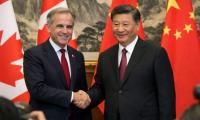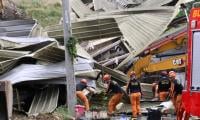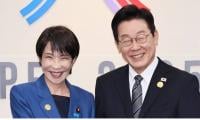Govt hints at bringing parity in gas, power tariffs
ISLAMABAD: The government has hinted at hiking the gas prices to bring parity in the prices of gas and electricity.
A meeting to discuss “Pakistan Natural Gas: Policy Issues & Way Forward” prepared by Integrated Energy Planning (IEP), Ministry of Planning, Development and Special Initiatives (M/o PD&SI) was held here on Thursday.
Ahsan Iqbal, Minister of PD&SI; Shahid Khaqan Abbasi, former prime minister; Khurram Dastagir Khan, Minister of Energy, and representatives of different energy sector organizations, including Oil and Gas Regulatory Authority (OGRA), Directorate General of Gas, Pakistan LNG Limited (PLL), Interstate Gas System (ISGS), Oil and Gas Development Company Limited (OGDCL), Central Power Purchasing Agency (CPPA-G), Sui Northern Gas Pipelines Limited (SNGPL), and Sui Southern Gas Company Limited (SSGC), attended the meeting.
An overview of the present status of production, import, and supply of natural gas in the country was discussed, followed by recommendations to improve the gas supply and demand through short-term and long-term policy interventions aimed at different levels.
It was briefed that over the years production of natural gas had declined to 3,505MMCF in 2021 compared to 4,063 MMCFD in 2010. Due to the depleting local gas resources, the balance recoverable reserves reached the level of 20,951 billion Cft in 2021.
The depletion trend projects that natural gas production will shrink to 2,306 MMCFD by 2030. The demand kept growing at a consistent pace although the government banned new connections in 2011 except residential/special commercial (roti tandoor) connections.
The growth in the residential connection was not prevented until December 2021. The domestic gas consumption for cooking purposes remained constant at 20,000 MMCFt per month however, this consumption increased to its peak in January up to 51,600 MMCFt. In January, space heating demand was 24,631 MMCFt and for water heating, it was 6,271 MMCFt, which increases the demand for gas in the domestic sector. To meet the shortfall, the government decided to import LNG in 2015. Initially, 282 MMCFD of LNG was imported in 2016, and this has increased aggressively over the years, reaching 1,162 MMCFD by 2021. To meet the country’s total gas demand, a net supply of 3548 MMCFD by 2030 would be needed, out of which, 1900 MMCFD will be met through LNG imports. The peak demand forecast is based on gas consumption in the winter season (with the highest peak in January).
A proposed mechanism for the demand-side management of gas was also discussed including the substitution of natural gas in the domestic sector with electricity.
To reduce the demand for gas in the domestic sector, gas prices can be rationalized where gas and electricity prices come to parity. This will encourage gas consumers to use electricity for space and water heating in the winter.
Substitution to electric appliances for space and water heating can save yearly an estimated 74,736 Million CFt in total. As a result, 6,778 Gigawatt hours (GWh) of least-cost electric power can be generated from gas.
Khurram Dastagir added that increased utilization of natural gas in the power sector could drastically reduce the electricity tariff.
It was highlighted in the meeting that the existing long-term contracts with Qatar Gas include a clause for contract revision in 2026, which also included a revision of the price cap and the supplier could demand an increase in the LNG delivered cost or just walk away from the contract. Therefore, Pakistan should expedite the process of entering into fresh long-term LNG import contracts.
The meeting discussed the improvement in the LNG import infrastructure including expansion in the LNG terminal and regasification capacity, the possibility of imported gas storage in exhausted gas wellheads, and the development of a North-South Gas pipeline.
The stakeholders suggested that at present, the development of gas storage infrastructure is not financially viable for the country, instead option of trading LNG at the lowest spot market rates could be considered, which is globally becoming a popular concept.
It was then suggested that instead of opting for an expensive subsurface (depleted reservoirs) gas storage option, gas storage over the surface (salt caverns) could be considered which has lower cost implications. Therefore, a feasibility study may be conducted to identify the cost and areas for such storage. On natural gas exploration and production (E&P) activities, it was discussed that the appropriate incentives including wellhead prices comparable with regional countries could be offered. It was highlighted by Mr. Ahsan Iqbal, that the development of the Turkmenistan-Afghanistan-Pakistan-India (TAPI) gas pipeline and Iran Pakistan Gas Pipeline was also discussed as a potential gas supply source for the country.
The session also discussed the possible gas pricing mechanism that could be developed. The consumer prices which are supposed to be revised biannually, could not be revised timely leading to the accumulation of a tariff differential of Rs577 billion till June 2022. The RLNG price is monthly determined and notified by Ogra, unlike indigenous gas consumer pricing where even biannual revisions could not be made.
The entire gas pricing is operating on cross-subsidy particularly to protect residential consumers, therefore, there has been no full cost recovery from cross-subsidized consumers.
The existing distortion in natural gas tariff could be eliminated and the tariff could be rationalized besides abolishing the cross-subsidy mechanism and replacing the same with a budgeted subsidy to protect the low-end / lifeline gas consumers. It was also discussed that the cost-reflective pricing of the gas sector will be a key decision to develop a sustainable natural gas supply chain in the country.
Ahsan Iqbal highlighted the need for energy security in which gas was a critical component. He expressed the need to educate the people about the difficulties the government faces to ensure a low-cost and sustainable gas supply in the country at a time when international gas prices are highly inflated and domestic gas reserves are depleting.
-
 Canadian PM Visits China After A Decade Of Diplomatic Strain: What Deals Are In Focus?
Canadian PM Visits China After A Decade Of Diplomatic Strain: What Deals Are In Focus? -
 New York Plans Limited Rollout Of Self-driving Taxis
New York Plans Limited Rollout Of Self-driving Taxis -
 Sarah Ferguson Faces Painful Choice Between Peace, Family Bond
Sarah Ferguson Faces Painful Choice Between Peace, Family Bond -
 Nvidia Clarifies ‘no Upfront Payment Needed For H200 Chips Production’
Nvidia Clarifies ‘no Upfront Payment Needed For H200 Chips Production’ -
 Africa First: Nigeria Set To Approve Landmark AI Rules For Digital Economy
Africa First: Nigeria Set To Approve Landmark AI Rules For Digital Economy -
 WhatsApp Tests Built-in Supervision Feature Long Missing From The App
WhatsApp Tests Built-in Supervision Feature Long Missing From The App -
 Iceberg A-23A Turns Blue As Scientists Warn Collapse Is Imminent
Iceberg A-23A Turns Blue As Scientists Warn Collapse Is Imminent -
 FIFA Selects Stats Perform For Betting Data And Live Streaming
FIFA Selects Stats Perform For Betting Data And Live Streaming -
 Is Jessica Simpson Really Joining 'The Bachelorette'?
Is Jessica Simpson Really Joining 'The Bachelorette'? -
 Brayden Point Injury Raises Concern After Early Exit For Tampa Bay Lightning
Brayden Point Injury Raises Concern After Early Exit For Tampa Bay Lightning -
 Meghan Trainor Addresses 'toxic Mom Group' Rumours Again
Meghan Trainor Addresses 'toxic Mom Group' Rumours Again -
 Mattel Autistic Barbie Doll Aims To Boost Representation And Inclusion
Mattel Autistic Barbie Doll Aims To Boost Representation And Inclusion -
 William Makes Calculated Move To Future-proof His Public Role Amid Harry Return
William Makes Calculated Move To Future-proof His Public Role Amid Harry Return -
 Elijah Wood Breaks Silence On Possible Return To New 'Lord Of The Rings' Film
Elijah Wood Breaks Silence On Possible Return To New 'Lord Of The Rings' Film -
 Aaron Rodgers Wife: What The NFL Quarterback Has Said About His Marriage
Aaron Rodgers Wife: What The NFL Quarterback Has Said About His Marriage -
 Buckingham Palace Shuts Down Claims It Can Step In On Harry’s Security
Buckingham Palace Shuts Down Claims It Can Step In On Harry’s Security



